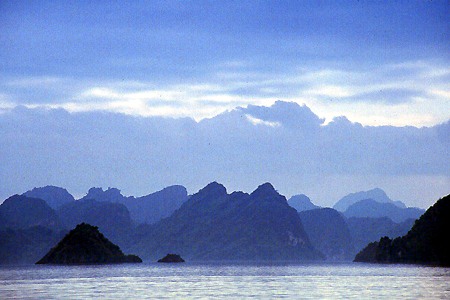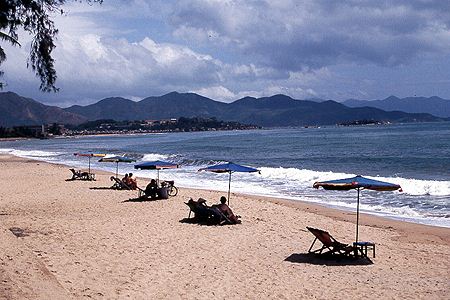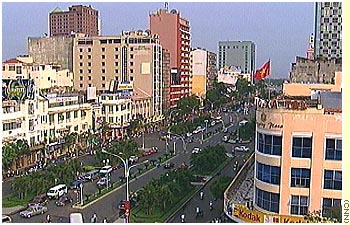To me, Viet Nam has a nice balance in that it is totally exotic, yet also very accessible: people are friendly and welcoming, it's easy to get around, it doesn't feel phony or contrived, and it's cheap. Another big factor: there's little to fear, so if a small outdoor restaurant in a side alley looks inviting, you can go where the spirit moves you. So, it's easy to have those "National Geographic" moments.
 I have met lots of people who have had excellent adventures here; however, I have also met people who have been perfectly miserable. What makes the difference? Expectations perhaps, and a willingness to roll with the punches. Saigon, Hanoi, and Hue are not Hong Kong, Chicago, or London; even a First Class traveller is going to be exposed to more grittiness and rough edges than you would encounter in Singapore or even Beijing. You can travel 5-star, 3-star, or low budget/backpacker. There's lots of information about touring Viet Nam on the web and in print, so I'll try not to be redundant. The more you know the better off you'll be, but anyway it always looks a lot different when you're on the ground in person than it does in the travel guide books and web sites.
I have met lots of people who have had excellent adventures here; however, I have also met people who have been perfectly miserable. What makes the difference? Expectations perhaps, and a willingness to roll with the punches. Saigon, Hanoi, and Hue are not Hong Kong, Chicago, or London; even a First Class traveller is going to be exposed to more grittiness and rough edges than you would encounter in Singapore or even Beijing. You can travel 5-star, 3-star, or low budget/backpacker. There's lots of information about touring Viet Nam on the web and in print, so I'll try not to be redundant. The more you know the better off you'll be, but anyway it always looks a lot different when you're on the ground in person than it does in the travel guide books and web sites.
Are you ready to rock and roll?
 GEOGRAPHY
GEOGRAPHY
Viet Nam has 3 separate regions: North, Central, and South. It's also been described as a barbell with a long mountain chain/coastal plain connecting the two wide ends. The ends consist of the two great river deltas where rice farming dominates the landscape and great majority of the population lives: the Red River in the north centered on Hanoi, and the Mekong River in the south with Ho Chi Minh City as the nexus. In between the two great river deltas (from Hanoi to HCMC is about 1200 miles/2000 km), the mountain form the spine of the country and the coastal plain between the mountains and the sea varies in width and character; in some places the mountains come right down to the sea, at others the coastal plains and foothills can extend for many miles.
{two notes: first, all distances in Viet Nam are in kilometers; this is one area where we in the USA really lag behind the rest of the world. Second, no one will ever hassle you for saying Saigon instead of Ho Chi Minh City, but politeness and political correctness prevail if you are doing business or have official dealings}
See my travel caveats, avoid the cow patties that others have already stepped in.
 WEATHER
WEATHER
Viet Nam is a tropical country. Climate in the North does tend more toward 4-seasons: days from December to February are generally overcast but a sweater or sweatshirt is all you need to feel comfortable, summer is no worse than Chicago. In the South it's either Rainy season (from May to November) or Sunny season. Temperatures in HCMC tend to be quite moderate, during monsoon season the rains usually come and go after cooling things down and washing down the city, the downside being its effect on motorcyclists (which is just about everybody). It's never a bad idea to have a cheap plastic raincoat handy (ao mua, raincoat, is also slang for condom). The Central region's rainy/sunny seasons are somewhat offset from the South, with sunny season from February to August. In the mountains it's always a good idea to keep a sweater around, especially at night.
FOOD
Imagine, eating at a Vietnamese restaurant EVERY day, does it get any better than that? Seriously though, food is one of the glories of the country. COM (Rice) obviously, is the backbone of the local diet. The ocean is not far away and CA (fish), CUA (crab), and TOM (shrimp) are abundant, delicious, and cheap. BO (Beef), GA (chicken), and HEO (pork) dishes are common. PHO, noodle soup with chicken or beef is the national dish. You can eat at a nice sit-down restaurant, or eat local style at a street stand where what's being served is on display.
For the record, I have eaten dog; frankly, it's not very tasty, and I have eaten worse things here anyway. It's not widespread in the country, but it does happen and restaurants are identified by the sign THIT CHO (dog meat). It's a cultural issue: people in India are horrified that I make a meal of Elsie the Cow. You have to look for it here anyway, it's not blatant or obvious.

NITTY-GRITTY
So, what do you really need to know?
- Money: dollars are usually accepted in payment, but it's easier to convert to VN Dong at banks and money changers (today 15,575 VND to 1 Dollar, $100 = 1,575,000 VND: mentally I roughly figure a 2000VND note = 15 cents, 5000VND = 35 cents, 10,000 = 65 cents, 20,000 = $1.30, 50,000 = $3.20, 100,000 = $7.00). In a pinch, you can change money at jewelry shops. Changing it on the street should be avoided, it's an easy way to get ripped off. ATMs can be found at banks in the larger cities, and they work like a charm, usually.
- Transportation: getting around is easy and farily inexpensive. In the cities, taxis are common (and metered). The bicycle rickshaw (cyclo) is charming and fun for sightseeing. The most common means of local transport is on the back of a motorcycle XE OM, hugging ride; you can go anywhere, and virtually any guy sitting on his motorcycle on a street corner will offer this service. Between towns, tourist buses and minibuses are popular for anything under 200km distance. Vietnam Airlines is quite reasonable and convenient when going farther. The train is for the adventurous only, and the most adventurous can travel by bus with the locals.
- Internet/Telecomm: internet access is widely available, with the bigger cities offering high-speed ADSL. The usual charge at Internet cafes is about 25 cents an hour. Unlike China where an army of internet censors is on active duty, VN is pretty loose. Most internet cafes also offer VoIP phones for international calls which are dirt cheap (4 cents a minute) but the quality can vary widely depending on how much chatting, music downloads, and games are being used in the cafe at the same time. Normal telephone service is at the post office (BUU DIEN).
- Medical care: in-country medical services are two-tier: in the large cities, expensive private high-quality services for those who can afford it, and everyone else goes thru the state-run system. I have used both, but most of my issues have been run-of-the-mill. For a significant illness or injury, a quick evacuation to Bangkok, Thailand is a good bet. One thing I do like here, there is no prescription required for drugs, which are significantly cheaper than in the USA.
In Viet Nam, a smile and a few US dollars are your passport to good service and a great experience.
Click here and fasten your seat belt.
|


